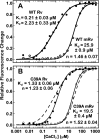A highly conserved cysteine of neuronal calcium-sensing proteins controls cooperative binding of Ca2+ to recoverin
- PMID: 24189072
- PMCID: PMC3861663
- DOI: 10.1074/jbc.M113.524355
A highly conserved cysteine of neuronal calcium-sensing proteins controls cooperative binding of Ca2+ to recoverin
Abstract
Recoverin, a 23-kDa Ca(2+)-binding protein of the neuronal calcium sensing (NCS) family, inhibits rhodopsin kinase, a Ser/Thr kinase responsible for termination of photoactivated rhodopsin in rod photoreceptor cells. Recoverin has two functional EF hands and a myristoylated N terminus. The myristoyl chain imparts cooperativity to the Ca(2+)-binding sites through an allosteric mechanism involving a conformational equilibrium between R and T states of the protein. Ca(2+) binds preferentially to the R state; the myristoyl chain binds preferentially to the T state. In the absence of myristoylation, the R state predominates, and consequently, binding of Ca(2+) to the non-myristoylated protein is not cooperative. We show here that a mutation, C39A, of a highly conserved Cys residue among NCS proteins, increases the apparent cooperativity for binding of Ca(2+) to non-myristoylated recoverin. The binding data can be explained by an effect on the T/R equilibrium to favor the T state without affecting the intrinsic binding constants for the two Ca(2+) sites.
Keywords: Allosteric Regulation; Calcium Signaling; Calcium-binding Proteins; Cooperativity; Cysteine; Mutant; Neuronal Calcium Sensor; Protein Myristoylation; Sulfenic Acid.
Figures







Similar articles
-
Oxidation mimicking substitution of conservative cysteine in recoverin suppresses its membrane association.Amino Acids. 2012 Apr;42(4):1435-42. doi: 10.1007/s00726-011-0843-0. Epub 2011 Feb 23. Amino Acids. 2012. PMID: 21344177
-
Amino-terminal myristoylation induces cooperative calcium binding to recoverin.J Biol Chem. 1995 Mar 3;270(9):4526-33. doi: 10.1074/jbc.270.9.4526. J Biol Chem. 1995. PMID: 7876221
-
Structure and calcium-binding studies of a recoverin mutant (E85Q) in an allosteric intermediate state.Biochemistry. 2002 May 7;41(18):5776-87. doi: 10.1021/bi012153k. Biochemistry. 2002. PMID: 11980481
-
Structural diversity of neuronal calcium sensor proteins and insights for activation of retinal guanylyl cyclase by GCAP1.Front Mol Neurosci. 2014 Mar 17;7:19. doi: 10.3389/fnmol.2014.00019. eCollection 2014. Front Mol Neurosci. 2014. PMID: 24672427 Free PMC article. Review.
-
Structure and membrane-targeting mechanism of retinal Ca2+-binding proteins, recoverin and GCAP-2.Adv Exp Med Biol. 2002;514:333-48. doi: 10.1007/978-1-4615-0121-3_20. Adv Exp Med Biol. 2002. PMID: 12596931 Review.
Cited by
-
Site-specific fluorescent labeling to visualize membrane translocation of a myristoyl switch protein.Sci Rep. 2016 Sep 8;6:32866. doi: 10.1038/srep32866. Sci Rep. 2016. PMID: 27605302 Free PMC article.
-
Bringing the Ca2+ sensitivity of myristoylated recoverin into the physiological range.Open Biol. 2021 Jan;11(1):200346. doi: 10.1098/rsob.200346. Epub 2021 Jan 6. Open Biol. 2021. PMID: 33401992 Free PMC article.
-
The Binding Properties and Physiological Functions of Recoverin.Front Mol Neurosci. 2018 Dec 20;11:473. doi: 10.3389/fnmol.2018.00473. eCollection 2018. Front Mol Neurosci. 2018. PMID: 30618620 Free PMC article. Review.
-
Light-Induced Thiol Oxidation of Recoverin Affects Rhodopsin Desensitization.Front Mol Neurosci. 2019 Jan 7;11:474. doi: 10.3389/fnmol.2018.00474. eCollection 2018. Front Mol Neurosci. 2019. PMID: 30666186 Free PMC article.
-
Oxidative stress sensing and response in neural stem cell fate.Free Radic Biol Med. 2021 Jun;169:74-83. doi: 10.1016/j.freeradbiomed.2021.03.043. Epub 2021 Apr 18. Free Radic Biol Med. 2021. PMID: 33862161 Free PMC article.
References
-
- Klenchin V. A., Calvert P. D., Bownds M. D. (1995) Inhibition of rhodopsin kinase by recoverin: further evidence for a negative feedback system in phototransduction. J. Biol. Chem. 270, 16147–16152 - PubMed
-
- Chen C. K., Inglese J., Lefkowitz R. J., Hurley J. B. (1995) Ca2+-dependent interaction of recoverin with rhodopsin kinase. J. Biol. Chem. 270, 18060–18066 - PubMed
-
- Higgins M. K., Oprian D. D., Schertler G. F. (2006) Recoverin binds exclusively to an amphipathic peptide at the N terminus of rhodopsin kinase, inhibiting rhodopsin phosphorylation without affecting catalytic activity of the kinase. J. Biol. Chem. 281, 19426–19432 - PubMed
Publication types
MeSH terms
Substances
Associated data
- Actions
- Actions
- Actions
- Actions
Grants and funding
LinkOut - more resources
Full Text Sources
Other Literature Sources
Molecular Biology Databases
Miscellaneous

